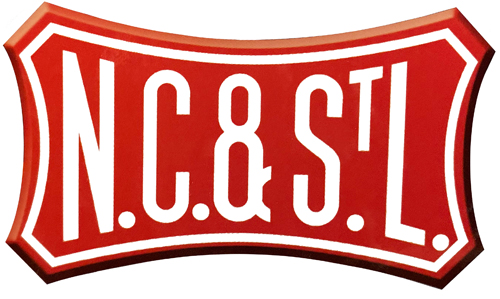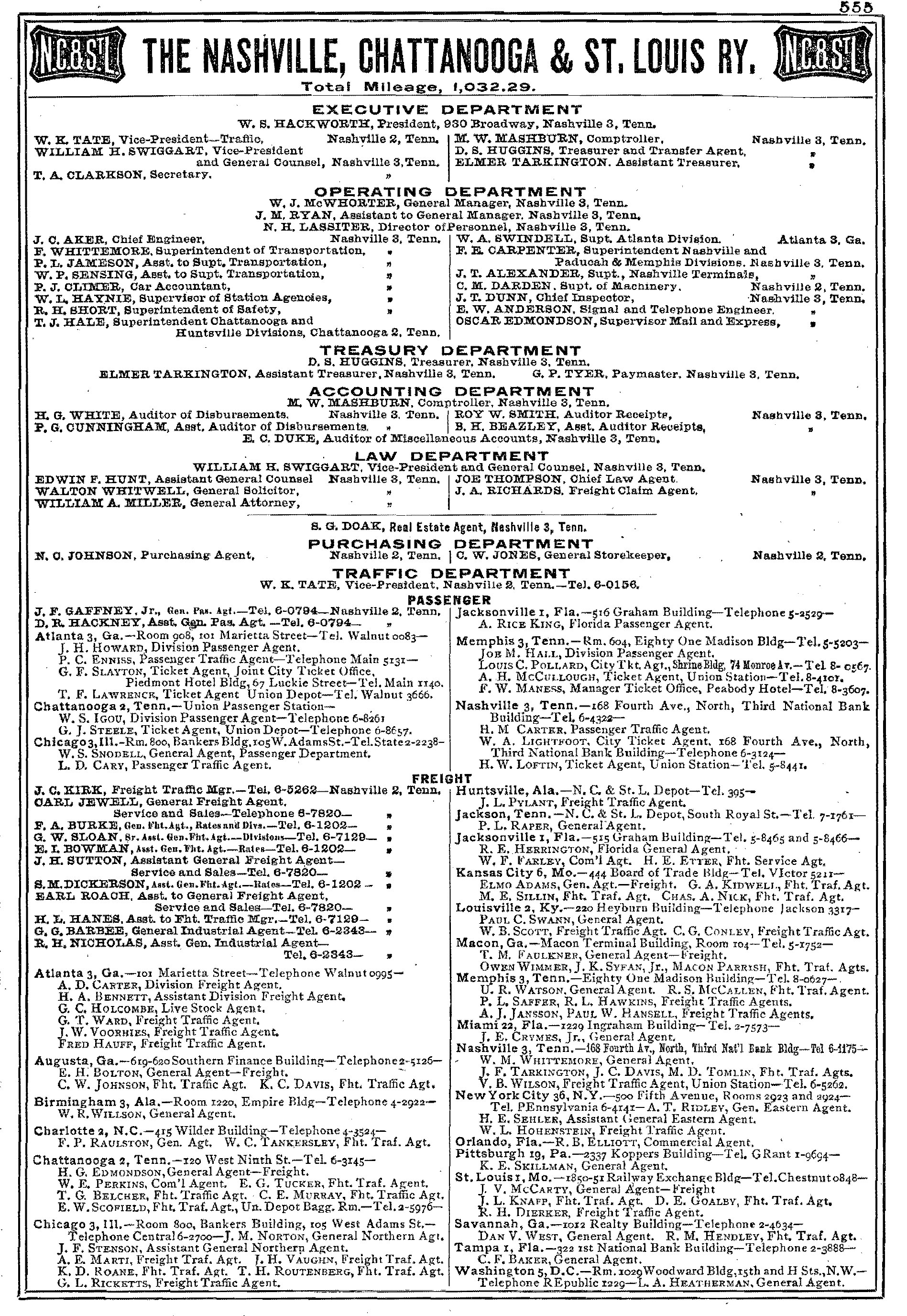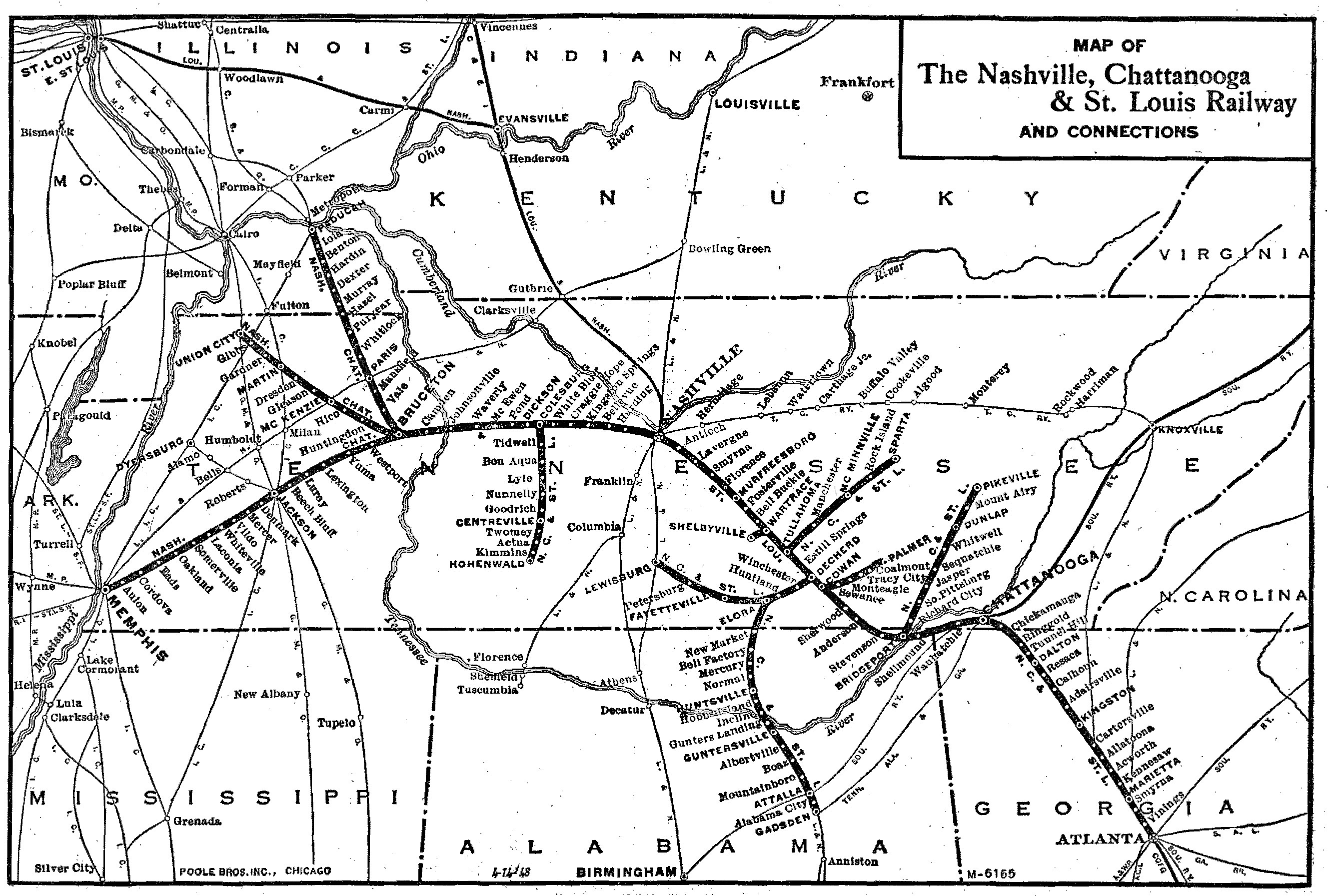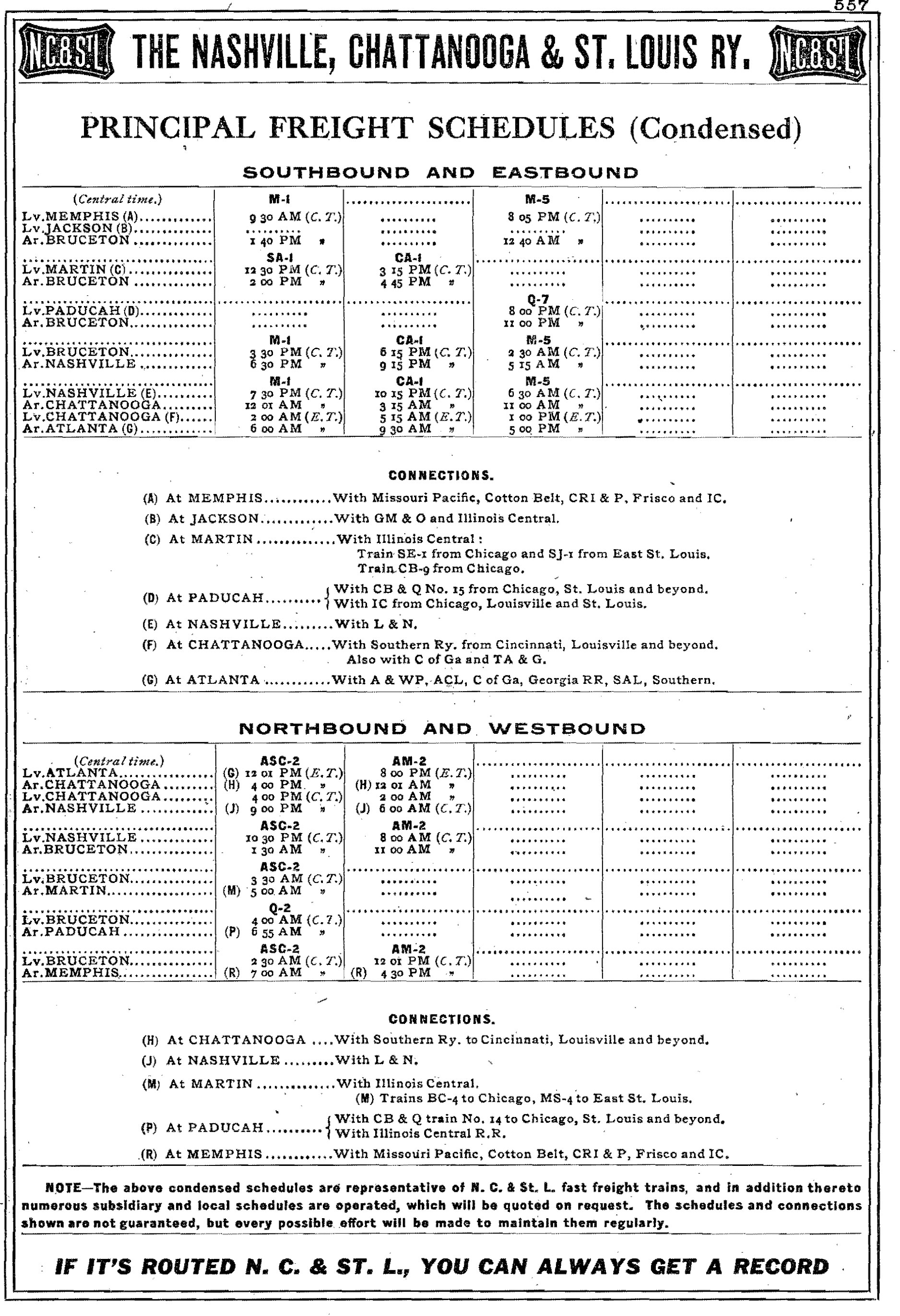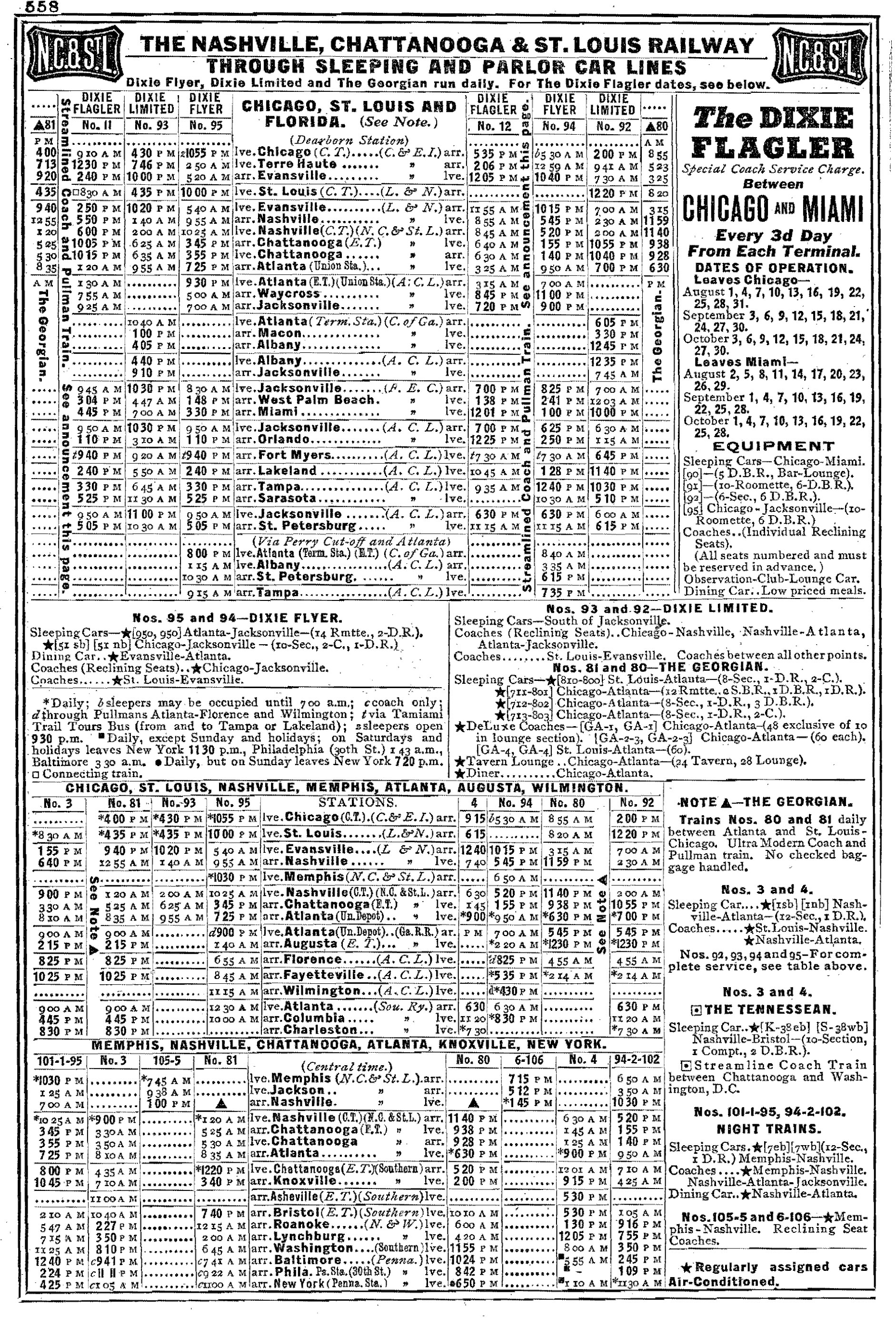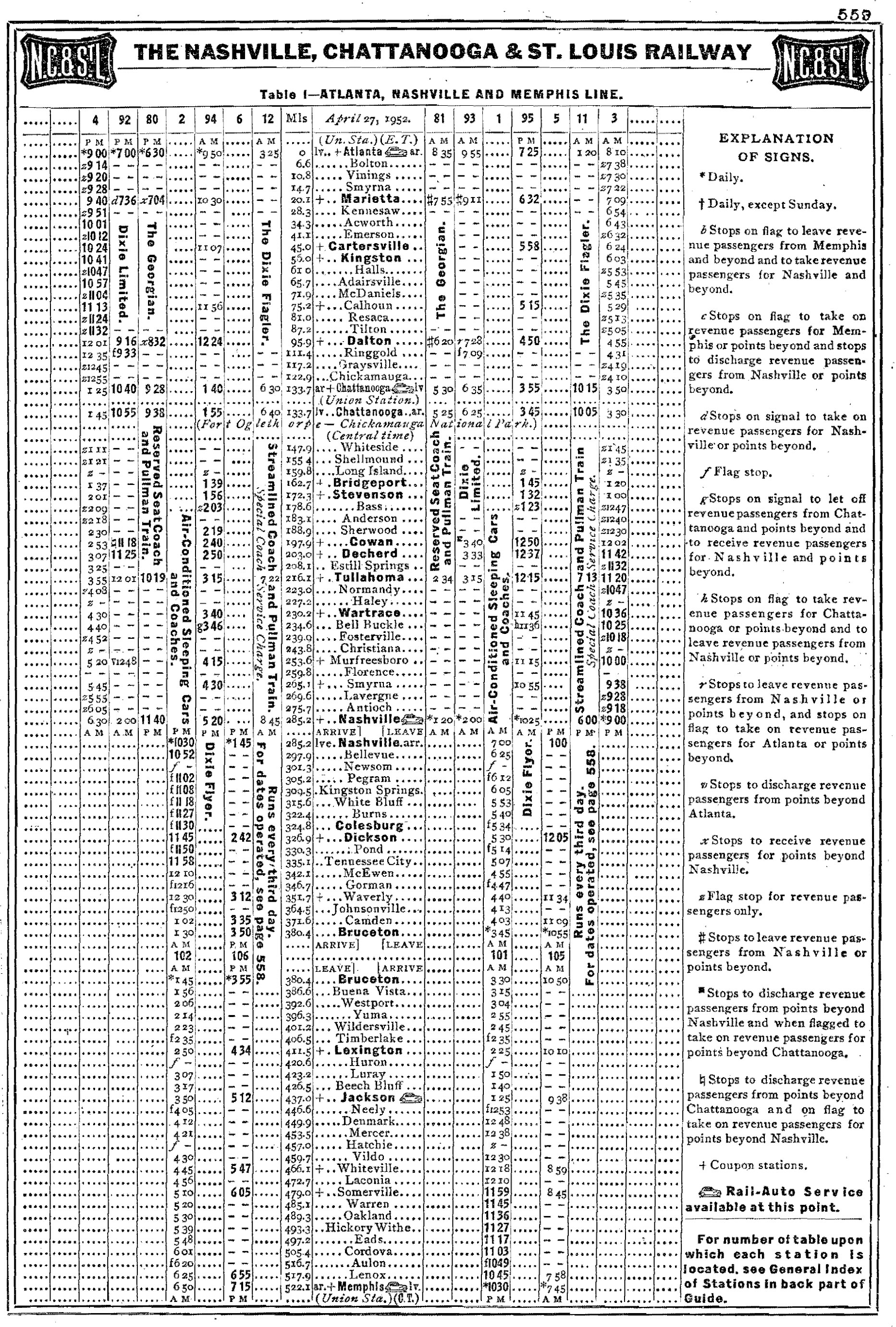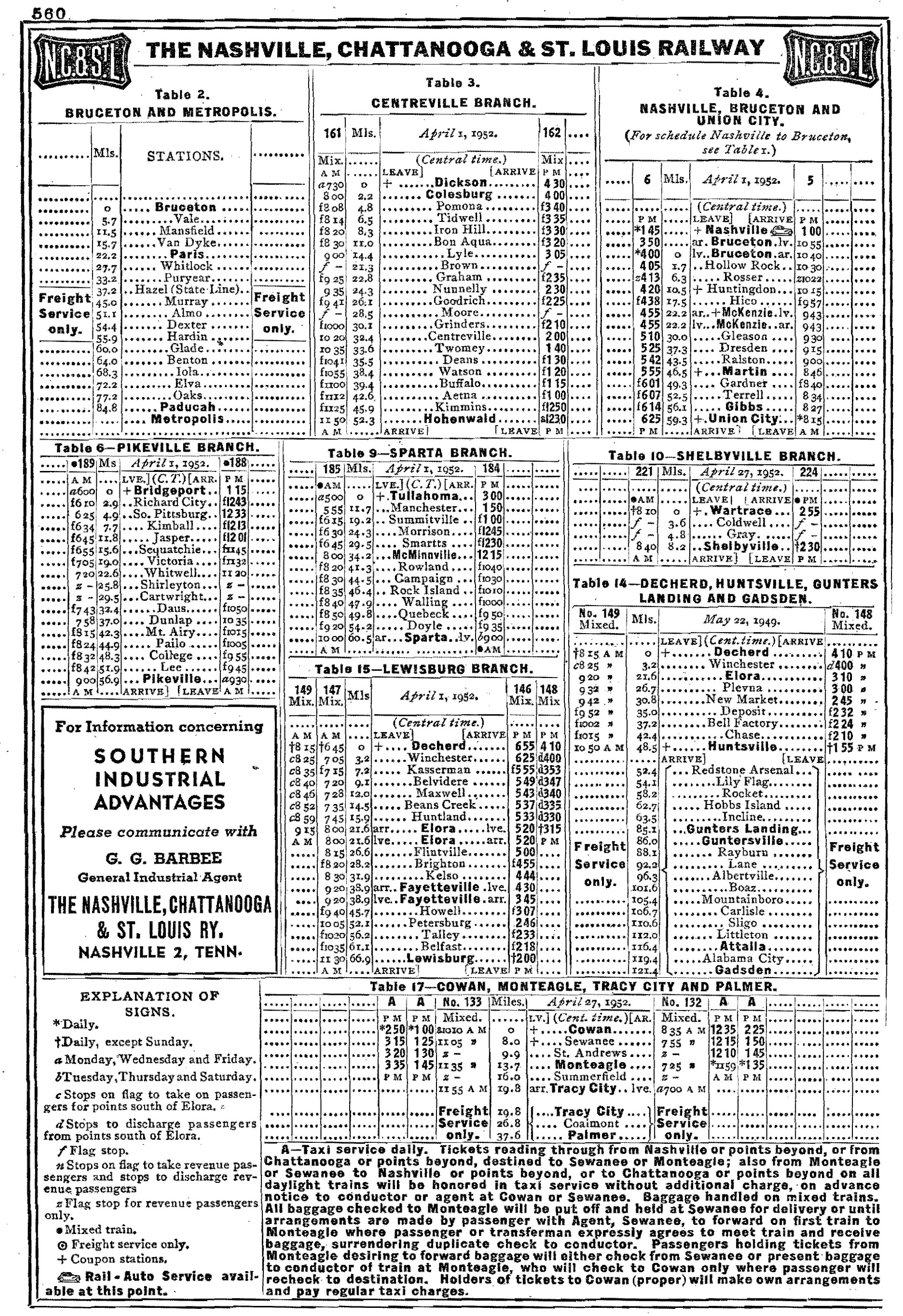Nashville, Chattanooga and St. Louis Railway: Map, History, Logo
Last revised: October 13, 2024
By: Adam Burns
The Nashville, Chattanooga and St. Louis Railway, also known as the Dixie Line, has a history dating
back to the mid-1840s, chartered as the Nashville
& Chattanooga to connect its namesake cities.
At its height the NC&StL stretched across much of Tennessee linking the major cities of Atlanta, Memphis, Chattanooga, Nashville, Lexington, and even the western tip of Kentucky.
The railroad was under constant attack during the Civil War by both the North and South as they battled for control of the strategic line.
In the early 1870's it was reincorporated as the Nashville, Chattanooga & St. Louis. After the war there were great ambitions to extend the railroad into the Midwest and other points throughout the South.
However, these dreams were cut short when the road came under Louisville & Nashville's control.
The NC&StL ultimately settled into a regional role as a bridge line and remained an important component of the L&N before formally disappearing in the 1950s. Today, segments remain in use under CSX Transportation
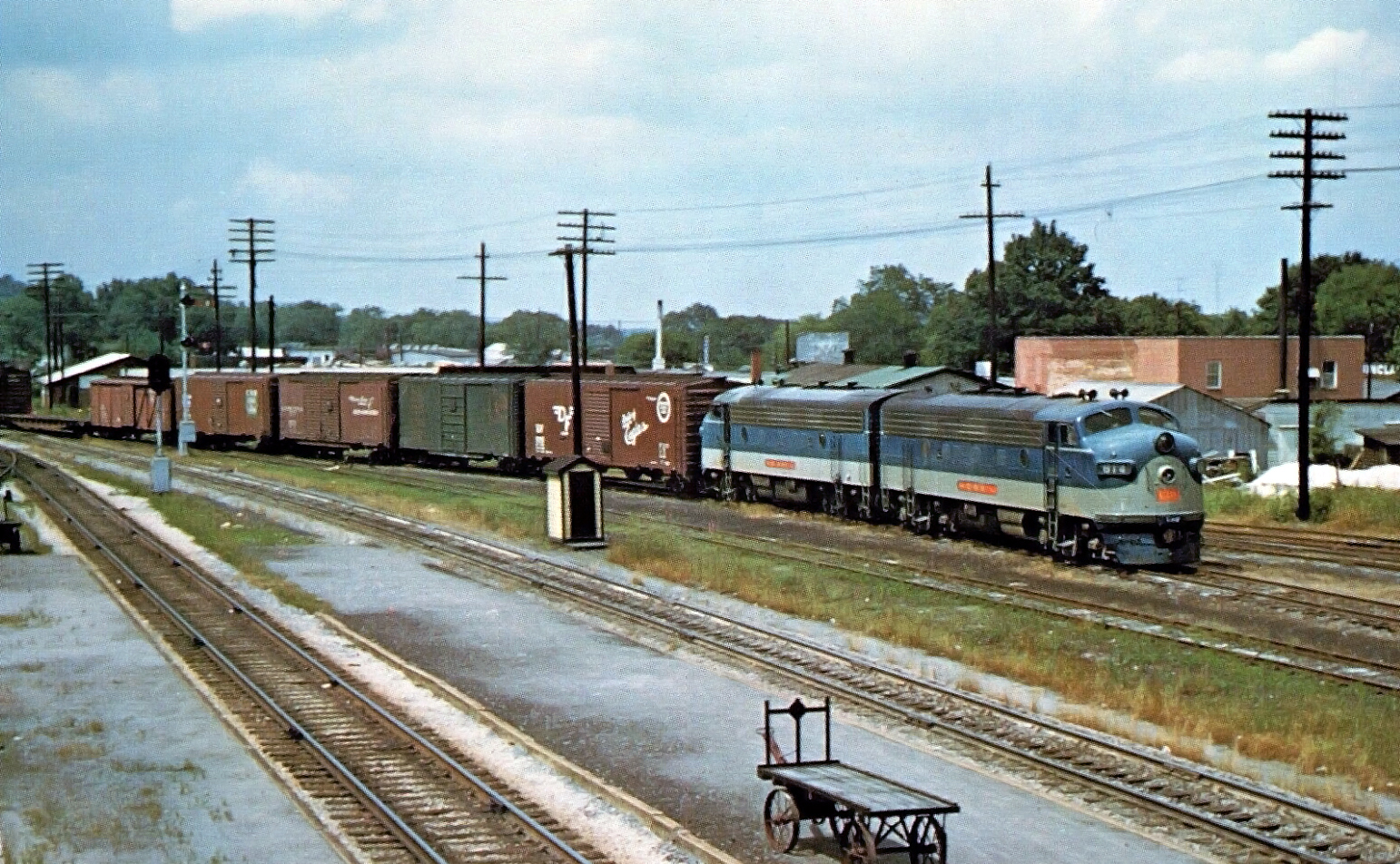 A pair of Nashville, Chattanooga & St. Louis F7A's have a mixed freight at Dalton, Georgia circa 1957. Clarence Cade photo.
A pair of Nashville, Chattanooga & St. Louis F7A's have a mixed freight at Dalton, Georgia circa 1957. Clarence Cade photo.History
The predecessor of the Nashville, Chattanooga & St. Louis Railway lays claim as Tennessee's first constructed railroad.
According to Dain Schult's book, "Nashville, Chattanooga & St. Louis: A History Of 'The Dixie Line'," the Nashville & Chattanooga Railroad was chartered on December 11, 1845 by Tennessee's General Assembly.
It was given rights to connect its namesake cities, establish a connection with the Western & Atlantic (W&A) at Chattanooga, and eventually reach major ports throughout the Southeast (presumably this would have entailed reaching Savannah, Wilmington, and Charleston).
The road's notable promoters included Vernon Stevenson, Alfred Nicholson, Dr. James Overton, James Whiteside, and James Jones. Of this group, Stevenson and Overton stood above the rest, working very hard to secure funding for the project.
In some cases, Stevenson literally went door-to-door to sell stock! Within a year enough had been sold that surveys were underway while construction officially commenced northwestward from Chattanooga in March of 1848.
Nashville & Chattanooga Railroad
A major challenge presented the railroad right out of Chattanooga, Raccoon Mountain. The N&C's chief engineer was John E. Thomson who decided to tackle the mountain head-on instead of opting for a longer route with a lower gradient. He chose a heading skirting the south bank of the river heading due west out of Chattanooga.
It hugged the northern tip of the mountain before entering the valley near Lookout Creek. From there it snaked its way southwesterly, roughly following the river in the process, until reaching Bridgeport, Alabama.
It reached as far as Stevenson in the "Heart of Dixie" before turning northward and back into Tennessee at Anderson. Slightly south of Cowan was the project's other significant obstacle, Cumberland Mountain.
It was decided a tunnel was the only option and the project commenced immediately in the summer of 1848. As crews worked eastward from Nashville the tunnel ultimately delayed the line's completion.
During the era predating the Civil War the backbreaking work was largely carried out by slave labor. The 2,200-foot bore required four years, finally opening in February of 1852. As the tunnel was under construction work continued towards towards Nashville reaching Murfreesboro on July 4, 1851.
As Stuart Covington points out in his article, "NC&StL: Dixie Success Story" from the January, 1948 issue of Trains Magazine, with the N&C's right-of-way nearing completion Stevenson (elected N&C's first president), sailed off to England in search of cheaper iron than that available in the States.
Logo
The rails he ultimately purchased saved the company $50,000. Finally, during February of 1854 the 152-mile line, built to 5-foot broad gauge, was opened for service and established through service to Atlanta via the Western & Atlantic (W&A).
Western & Atlantic
The W&A carries an interesting history in itself. It was constructed by the state of Georgia to open trade from the state's north-central region at what eventually became Atlanta with Chattanooga. The railroad was founded on December 21, 1836 to build north from the town of Decatur.
Somewhat surprisingly during an era where nearly any town, large or small, yearned for a railroad and the economic opportunities it provided, city leaders wanted nothing to do with a railroad operating in city limits.
At A Glance
Atlanta - Chattanooga - Nashville - Memphis Bridgeport, Alabama - Pikeville, Tennessee Kingston - Rome, Georgia Cowan - Palmer, Tennessee Bridgeport - Orme, Tennessee Decherd, Tennessee - Elora, Tennessee - Gadsden, Alabama Elora - Columbia, Tennessee Colesburg - Allen's Creek, Tennessee Bruceton, Tennessee - Paducah, Kentucky Bruceton - Union City, Tennessee - Hickman, Kentucky | |
As a result, the southern terminus was moved to a location a few miles to the southwest which became known as Marthasville.
This town later became Atlanta in 1847. Construction of the W&A commenced in 1840 and following the completion of a 1,447-foot tunnel beneath Chetoogeta Mountain near Dalton in the spring of 1850 the 137-mile route was ready for service.
The first train reached Chattanooga on May 9, 1850. The W&A became a vital interchange partner with the N&C and the latter road eventually leased it in 1871. It was also an important asset of the Civil War, utilized by both sides although its most famous incident occurred during the spring of 1862.
Great Locomotive Chase
The so-called "Great Locomotive Chase" has earned legendary status, unfolding during the early years of the Civil War.
The clandestine military operation was carried out by Union forces and Northern sympathizers in an effort to destroy railroad infrastructure north of Atlanta in hopes of eventually capturing the strategic city of Chattanooga.
The celebrity locomotive in what was also known as Andrews' Raid was the Western & Atlantic's General. The American Type 4-4-0 steamer was commandeered by James Andrews himself (leader of the raid) and used throughout the chase where he traveled northward from Atlanta causing as much damage as he could.
Unfortunately, the hasty Union plans were too slow and disorganized to cause serious damage and most of those involved were eventually captured by Confederate forces who gave chase aboard the 4-4-0 Texas. Today, for history's sake the General remains preserved in Kennesaw, Georgia at the Southern Museum of Civil War & Locomotive History.
Expansion
As was all too common throughout the South the W&A and N&C suffered tremendously during the war. By 1864 both were under Federal control and rebuilt to serve the Union. After the conflict they were returned to private ownership.
Almost immediately the N&C was again expanding, leasing the Nashville & Northwestern Railroad in August of 1868. The N&NW was chartered by the Tennessee General Assembly on January 22, 1852 to open trade across the state's western territory.
If all went according to plan it would link Nashville with Hickman, Kentucky nestled in that state's far southwestern corner along the banks of Mississippi River and near the Tennessee border.
The 168-mile line was aided through acquisition of the small Hickman & Obion building towards Union City, Tennessee. The entire project was delayed by the war and in danger of being scrapped altogether.
However, the state stepped in and oversaw its completion in 1867, subsequently leasing it to the N&C. On May 30, 1873 a series of notable corporate changes occurred; on that day the N&NW became the Nashville, Memphis & St. Louis Railway while the N&C was renamed the Nashville, Chattanooga & St. Louis Railway (NC&StL).
As both Mr. Schult and Mr. Covington note, the new goal was St. Louis and a prominent Midwestern gateway.
In the spring of 1879 the NC&StL gained control of the Owensboro & Nashville Railroad which had already completed a line between Owensboro and Central City, Kentucky with intentions of reaching Nashville.
Later that year the NC&StL worked out an agreement for control of the St. Louis & Southeastern which connected Evansville, Indiana and St. Louis. Unfortunately, both the StL&SE and O&N were disconnected from each other as well as the NC&StL.
There were large gaps between Central City-Nashville and Owensboro-Evansville which must be closed before through service could be established. Alas, fate stepped in and had different plans. Relations between the NC&StL and nearby rival Louisville & Nashville had deteriorated by the end of the 1870s.
The latter road was in much better financial condition and realized a NC&StL extension to the Gateway City would seriously harm its competitive standing.
Louisville & Nashville Control
Using sly business tactics L&N managed to gain stock control of the NC&StL in January of 1880.
While the Dixie Line never reached St. Louis it did continue expanding while becoming both a successful bridge line and important component of the L&N. Just prior to the takeover an independent NC&StL gained control of the small Tennessee & Pacific.
A road with grand plans, it only completed a short section from Nashville to Lebanon where interchange was established with the Nashville & Knoxville Railroad (later Tennessee Central Railway).
On March 1, 1877 it became the NC&StL's Lebanon Branch. Later that same year, on July 28th, it acquired two moribund properties from the Memphis & Charleston, the McMinnville & Manchester and Winchester & Alabama.
The former road connected with the NCSt&L at Tullahoma and stretched 35 miles to McMinnville. It was extended to Sparta in 1884 and subsequently reached Bon Air, Tennessee via the Bon Air Railroad (controlled since December of 1877).
The branch provided mostly coal traffic. The W&AL branched away from the NC&StL at Decherd and terminated at Fayetteville.
The new owner quickly pushed rails further south to Huntsville, Alabama and in 1893 reached Hobbs Island on the north bank of the Tennessee River.
The Dixie Line completed its final extension into Alabama through purchase of the Tennessee & Coosa Railroad in 1891, running from the south bank of the river at what became Guntersville to Gadsen.
Another notable branch was located west of Nashville. According to Dr. George Hilton's book, "American Narrow Gauge Railroads," on July 20, 1880 the NC&StL acquired the Nashville & Tuscaloosa Railroad.
This three-foot line linked Graham with the NC&StL main line near Colesburg, Tennessee, not far from Dickson (24 miles).
The narrow-gauge, incorporated on June 6, 1877, was intended to reach Tuscaloosa but ran out of funding. To extend further southward the road's owners worked out a deal for the NC&StL to takeover the property.
Rails were pushed to Centreville, and finally Kimmins in 1884. This concluded construction of the N&T although it was extended further south to Mannie/Allens Creek via acquisition of a private narrow-gauge line owned by the Southern Iron Company.
The little road was purchased on September 24, 1892 and the branch reached its final length of 63 miles (there was also a small 2-mile spur connecting Lyles with Warner). During July of 1894 the branch was converted to standard-gauge as the NC&StL had carried out a similar project in 1886 across much of its own property.
Its next acquisition came in early 1887 when it took over the Tennessee Coal, Iron & Railroad Company (TCI&RR). This short coal branch connected with the NC&StL at Cowan running northeasterly to Tracy City.
It was extended as far as Palmer in 1918. Coinciding with the TCI&RR takeover in 1887 was the purchase of another three-foot property, the Duck River Valley Narrow-Gauge Railroad.
System Map (1939)
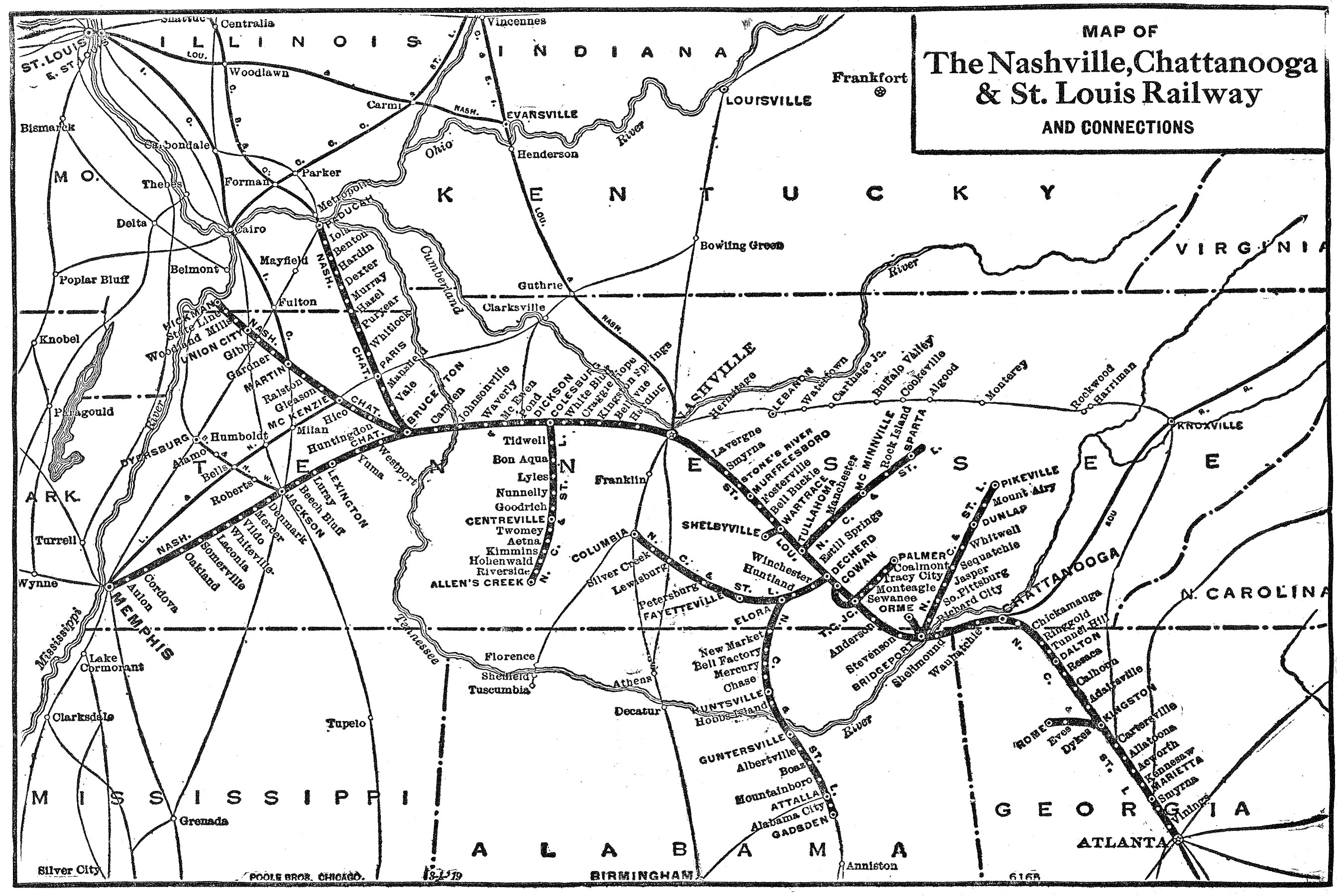 An official, 1919 system map of the Nashville, Chattanooga & St. Louis Railway. Author's collection.
An official, 1919 system map of the Nashville, Chattanooga & St. Louis Railway. Author's collection.As Dr. Hilton points out it was chartered on November 4, 1870 to construct a route from the-then N&C main line near Nashville with Huntsville, Alabama running via Columbia and Fayetteville.
It opened between Lewisburg and Columbia (interchanging there with the L&N) in March of 1877 and reached as far as Petersburg before financing was exhausted.
It was first leased by the NC&StL in September of 1879 in exchange for completion of the line to Fayetteville, which opened in March of 1882.
In 1889 the NC&StL completed its conversion to standard gauge and from Fayetteville interchanged with the NC&StL-controlled Winchester & Alabama Railroad to Decherd.
Further growth occurred in 1894 with the completion of the Sequatchie Valley Branch to Pikeville, Tennessee. The road had been acquired by the N&C in 1877 and opened as far as Jasper in 1878 before its extension further north sixteen years later. As with most Dixie Line branches, coal was the primary commodity.
The last two additions came during 1895 and 1896 by leasing three roads; the Paducah & Memphis gave NC&StL access to the major terminal of Memphis while the L&N-owned Paducah, Tennessee & Alabama and Tennessee Midland added a long branch to the Ohio River at Paducah, Kentucky.
Passenger Trains
City Of Memphis: (Nashville - Memphis)
Diesel Roster
American Locomotive Company
| Model Type | Road Number | Date Built | Quantity |
|---|---|---|---|
| S1 | 1-4 | 1941-1946 | 4 |
| S2 | 5-11 | 1942-1946 | 7 |
Baldwin Locomotive Works
| Model Type | Road Number | Date Built | Quantity |
|---|---|---|---|
| VO-660 | 10 | 1941 | 1 |
| VO-1000 | 15, 30-34 | 1941-1943 | 6 |
Electro-Motive Division
| Model Type | Road Number | Date Built | Quantity |
|---|---|---|---|
| SW-1 | 15 (Ex-GN) | 1950 | 1 |
| NW2 | 20-23, 25 | 1941, 1949 | 5 |
| SW7 | 24-33 | 1950 | 10 |
| SW9 | 34-38 | 1951 | 5 |
| GP7 | 700-731, 750-754 | 1950-1952 | 37 |
| F3A | 800-808 | 1948-1949 | 9 |
| F7A | 809-831 | 1949-1951 | 23 |
| F3B | 900-911 | 1948-1949 | 12 |
| F7B | 912-919 | 1949-1950 | 8 |
General Electric
| Model Type | Road Number | Date Built | Quantity |
|---|---|---|---|
| 44-Tonner | 100-103 | 1950 | 4 |
Steam Roster (As of 1943)
| Class | Road Number(s) | Type | Wheel Arrangement | Builder |
|---|---|---|---|---|
| G-O | 216 | Ten-Wheeler | 4-6-0 | Rogers |
| G-6B | 250-254 | Ten-Wheeler | 4-6-0 | Baldwin |
| G-8A | 280-286 | Ten-Wheeler | 4-6-0 | Baldwin |
| H-4A | 341-342 | Consolidation | 2-8-0 | Baldwin |
| H-5 | 352-359,362,364 | Consolidation | 2-8-0 | Baldwin |
| H-5A | 368-373 | Consolidation | 2-8-0 | Baldwin |
| H-5C | 350-351,360-361,365,367 | Consolidation | 2-8-0 | Baldwin |
| H-6A | 374-383 | Consolidation | 2-8-0 | Baldwin |
| H-7B | 411-414,416,419 | Consolidation | 2-8-0 | Baldwin |
| H-7C | 384-410,415,417-418 | Consolidation | 2-8-0 | Baldwin |
| H-8C | 420-424 | Consolidation | 2-8-0 | Baldwin |
| H-9 | 450-459 | Consolidation | 2-8-0 | Baldwin |
| K-1 | 500-503 | Pacific | 4-6-2 | Baldwin |
| K-1A | 504-511 | Pacific | 4-6-2 | Baldwin |
| K-2 (A-D | 530-537 | Pacific | 4-6-2 | Baldwin |
| J-1 | 550-554 | Mountain | 4-8-2 | Alco |
| J-1A | 555-557 | Mountain | 4-8-2 | Baldwin |
| J-1C | 558-562 | Mountain | 4-8-2 | Baldwin |
| J-2 | 565-569 | "Dixie" | 4-8-4 | Alco |
| J-3 | 570-589 | "Dixie" | 4-8-4 | Alco |
| L-1 | 600-628 | Mikado | 2-8-2 | Baldwin |
| L-2 | 650,652-653,655-657 | Mikado | 2-8-2 | Baldwin |
| L-2A | 660-671 | Mikado | 2-8-2 | Baldwin |
| L-2B | 651-654,658-659 | Mikado | 2-8-2 | Baldwin |
| M-1 | 900-902 | "Chesapeake" | 2-8-8-2 | Baldwin |
| P-1 | 950-954 | Decapod | 2-10-0 | Baldwin |
Much of the above steam locomotive roster information is courtesy of Dain Schult's book, "Nashville, Chattanooga & St. Louis: A History Of 'The Dixie Line'."
20th Century Operations
At the turn of the 20th century the Nashville, Chattanooga & St. Louis reached its largest length, 1,195 miles.
During the next several decades it lost some mileage although by the post World War II period still maintained 1,052 route miles of which nearly 400 miles were protected by centralized traffic control (CTC).
The NC&StL's late era was fascinating from an operational standpoint. It utilized big steam in the form of 4-8-4 "Dixies," a small batch of 2-8-8-2 compound Mallet's, and 2-10-0 Decapod's to go along with standard road-power arrangements like the 2-8-2, 4-8-2, and 4-6-2.
While coal was generated in large volumes along its eastern branches the company handled a wide variety of freight from agriculture to merchandise.
It also operated time freights between Martin, Tennessee (handing off there with the Illinois Central) and Atlanta via Chattanooga by way of symbolled trains ASC-2 and ASC-4.
The NC&StL even entered the streamliner craze in the spring of 1947 when it launched the City of Memphis connecting Nashville with Memphis.
It also participated in through services with other carriers including the Georgian (Chicago - Atlanta), Dixie Flagler (Chicago - Miami), and DixieLand (Chicago - Miami).
The NC&StL remained a separate entity until March 1, 1957 when the Interstate Commerce Commission approved a formal merger with the L&N, which was carried out later that August.
Public Timetables (August, 1952)
Recent Articles
-
New York - Murder Mystery - Dinner Train Rides
Dec 13, 25 10:30 AM
New York State, renowned for its vibrant cities and verdant countryside, offers a plethora of activities for locals and tourists alike, including murder mystery train rides! -
Pennsylvania - Murder Mystery - Dinner Train Rides
Dec 13, 25 10:25 AM
Pennsylvania, steeped in history and industrial heritage, offers a prime setting for a unique blend of dining and drama: the murder mystery dinner train ride. -
Ohio - Murder Mystery - Dinner Train Rides
Dec 13, 25 10:14 AM
The murder mystery dinner train rides in Ohio provide an immersive experience that combines fine dining, an engaging narrative, and the beauty of Ohio's landscapes.

